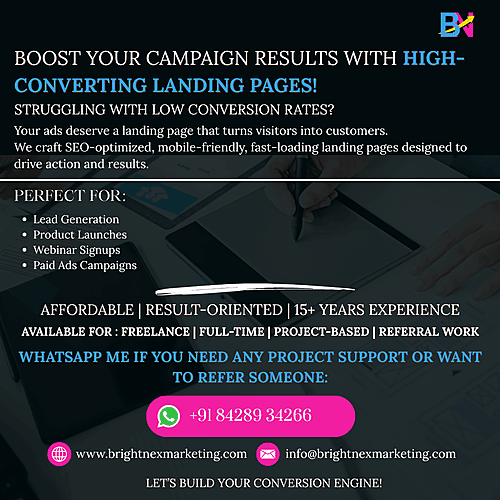Introduction: Why Your SaaS Landing Page Matters
A SaaS landing page is more than just a digital welcome mat—it's the bridge between curiosity and conversion. Whether you're offering a free trial or showcasing your core features, your landing page needs to be engineered for performance. A well-optimized SaaS landing page has the power to convert casual visitors into loyal customers. But how do you design one that truly works?
In this guide, we’ll walk you through the essential steps and best practices to design a SaaS landing page that not only attracts but converts.
1. Understand Your Audience Before You Start Designing
Before opening any design tool or writing copy, get crystal clear about who your audience is. SaaS users are often looking for fast, frictionless solutions to specific problems. Your landing page must speak directly to their pain points and position your product as the answer.
Tips:
2. Craft a Clear, Action-Oriented Headline (With Subheadline)
Your headline is the first thing users see—it should grab attention and explain what your SaaS product does in 1–2 lines.
Best Practices:
Keep it simple and benefit-driven.
Include a supporting subheadline that explains value.
Make sure it relates directly to your CTA.
Example:
"Streamline Your Workflow in Minutes – All-in-One SaaS Project Manager Built for Remote Teams"
3. Use a Focused Call-to-Action (CTA)
A strong SaaS landing page has one primary goal—getting the user to take action. Whether it’s signing up for a trial or requesting a demo, your CTA should be impossible to miss.
Tips:
Use contrasting colors to highlight the CTA button.
Limit your page to a single conversion goal.
Use action verbs: Start Free Trial, Get Demo, Try for Free.
4. Highlight Key Features and Benefits Strategically
People don’t just want to know what your product does—they want to know how it helps them. A good SaaS landing page clearly differentiates between features (what it does) and benefits (what the user gains).
Layout Suggestions:
Use icons or illustrations for visual clarity.
Break content into short paragraphs or bullets.
Lead with the most impactful benefits at the top.
5. Use Social Proof to Build Trust
Adding testimonials, client logos, ratings, or case studies can dramatically improve conversions. It adds credibility and helps reduce buyer hesitation.
What You Can Include:
Customer testimonials with photos
Video reviews or success stories
Real-time user stats or usage metrics
Pro Tip: Place your most compelling proof near your CTA.
6. Simplify Your Design & Optimize for Mobile
Cluttered designs lead to distracted users. Your SaaS landing page should be clean, fast-loading, and mobile-responsive. Use plenty of white space to improve readability and draw attention to key elements.
Design Principles:
Stick to 2-3 colors that match your brand.
Use consistent fonts and sizes.
Test your layout on mobile and tablet devices.
7. Reduce Friction in Your Forms
Every field in your form creates a chance for drop-off. For a SaaS product, keep your form as short as possible—ideally, just an email and password or name.
Additional Tips:
Avoid asking for unnecessary info early.
Use inline form validation for a better experience.
Show privacy assurance: “We’ll never share your email.”
8. Include Visuals That Demonstrate Value
Visual content—like product screenshots, explainer videos, and interactive demos—can improve engagement and reduce bounce rates. A picture is worth a thousand clicks on a SaaS landing page.
Visual Elements to Use:
Before/after visuals
Product walkthrough videos
Animated UI snippets or sliders
9. SEO Optimize Your SaaS Landing Page Content
To rank in Google, your landing page content must be keyword-rich but naturally written. Incorporate your focus keyword, SaaS landing page, into headings, alt tags, meta descriptions, and throughout the copy (as we’ve done here).
SEO Essentials:
Include schema markup where relevant.
Optimize page load speed (under 3 seconds).
Add alt text to images using variations of the keyword.
10. A/B Test Everything and Optimize for Conversions
No matter how great your first version is, continuous testing leads to higher performance. Run A/B tests on headlines, CTAs, images, and form layouts.
What to Measure:
Bounce rate
Time on page
CTA click-through rate
Conversion rate
Use tools like Google Optimize, Hotjar, or Optimizely to gather data.
Conclusion: Turn Clicks Into Customers with a High-Converting SaaS Landing Page
Creating a high-converting SaaS landing page isn’t about flashy design—it’s about clarity, value, and user-focused content. By understanding your audience, simplifying the experience, and optimizing your messaging, you can turn a passive visitor into an active, paying user.
Incorporate the steps above, run regular A/B tests, and keep refining your approach. A great SaaS landing page isn’t static—it evolves with your product and your users.
Need Help Designing Your SaaS Landing Page?
At BrightNex Marketing, we specialize in SaaS landing page design that drives real results. Get in touch today for a custom solution tailored to your business goals.



